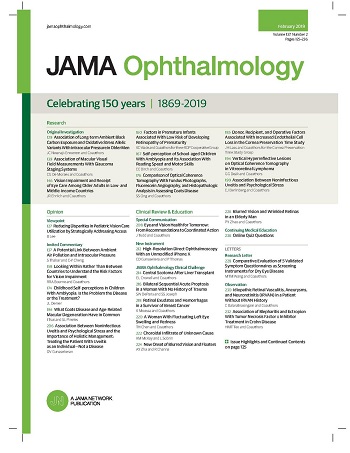Race, Social Determinants of Health, and the Quality of Diabetic Eye Care.
IF 7.8
1区 医学
Q1 OPHTHALMOLOGY
引用次数: 0
Abstract
Importance Besides race, little is known about how other social determinants of health (SDOH) affect quality of diabetic eye care. Objective To evaluate the association between multiple SDOH and monitoring for diabetic retinopathy (DR) in accordance with clinical practice guidelines (CPGs). Design, Setting, and Participants This cohort study was conducted in 11 US medical centers and included adult patients (18-75 years old) with diabetes. Patients received care from 2012 to 2023 and had 18 months or more of follow-up. Exposures Multiple SDOH and associated factors, including ethnicity, urbanicity of residence, health insurance type, and diabetes type. Main Outcomes and Measures Adjusted odds ratio (aOR) of receiving 1 or more eye-care visits and 1 or more dilated fundus examinations in accordance with CPGs. Results The study cohort included 37 397 adults with diabetes: 10 157 Black patients and 27 240 White patients. The mean (SD) age was 58 (11) years for Black patients and 59 (11) years for White patients. Of the Black patients, 6422 (63.2%) were female and 3735 (36.8%) male; of the White patients, 13 120 (48.1) were female and 14 120 (51.8) were male. Compared with those of the same race in urban communities, Black patients (aOR, 0.12; 95% CI, 0.04-0.31) and White patients (aOR, 0.75; 95% CI, 0.62-0.91) with diabetes living in rural communities had 88% and 25% lower odds of having eye-care visits, respectively. Sicker Black and White patients, defined by the Charlson Comorbidity Index, had 4% (aOR, 1.04; 95% CI, 1.02-1.06) and 5% (aOR, 1.05, CI 1.04-1.06) higher odds of having an eye-care visit, respectively. Black patients with preexisting DR had 15% lower odds of visits (aOR, 0.85, CI 0.73-0.99) compared with those without preexisting DR while White patients with preexisting DR had 16% higher odds of eye-care visits (aOR, 1.16; 95% CI, 1.05-1.28). White patients with Medicare (aOR, 0.85; 95% CI, 0.80-0.91) and Medicaid (aOR, 0.81; 95% CI, 0.68-0.96) had lower odds of eye-care visits vs patients with commercial health insurance. Hispanic White patients had 15% lower odds of eye-care visits (aOR, 0.85; 95% CI, 0.74-0.98) vs non-Hispanic White patients. White patients with type 1 diabetes had 17% lower odds of eye-care visits (aOR, 0.83; 95% CI, 0.76-0.90) vs those with type 2 diabetes. Among patients who had eye-care visits, those with preexisting DR (Black: aOR, 1.68; 95% CI, 1.11-2.53; White: aOR, 1.51; 95% CI, 1.16-1.96) were more likely to undergo dilated fundus examinations. Conclusions and Relevance This study found that certain SDOH affected monitoring for DR similarly for Black and White patients with diabetes while others affected them differently. Patients living in rural communities, Black patients with preexisting DR, and Hispanic White patients were not receiving eye care in accordance with CPGs, which may contribute to worse outcomes.种族、健康的社会决定因素和糖尿病眼科护理的质量。
重要性除种族外,人们对其他健康社会决定因素 (SDOH) 如何影响糖尿病眼科护理质量知之甚少。目的评估多种 SDOH 与根据临床实践指南 (CPG) 监测糖尿病视网膜病变 (DR) 之间的关系。主要结果和测量根据 CPGs 接受 1 次或 1 次以上眼科护理就诊和 1 次或 1 次以上散瞳眼底检查的调整后几率(aOR)结果该研究队列包括 37 397 名成年糖尿病患者:10 157 名黑人患者和 27 240 名白人患者。黑人患者的平均(标清)年龄为 58(11)岁,白人患者的平均(标清)年龄为 59(11)岁。黑人患者中有 6422 名(63.2%)女性,3735 名(36.8%)男性;白人患者中有 13120 名(48.1%)女性,14120 名(51.8%)男性。与城市社区的同种族患者相比,居住在农村社区的黑人糖尿病患者(aOR,0.12;95% CI,0.04-0.31)和白人糖尿病患者(aOR,0.75;95% CI,0.62-0.91)接受眼科治疗的几率分别降低了 88% 和 25%。根据夏尔森综合症指数(Charlson Comorbidity Index),病情较重的黑人和白人患者接受眼科检查的几率分别高出 4%(aOR,1.04;95% CI,1.02-1.06)和 5%(aOR,1.05,CI 1.04-1.06)。与没有 DR 的患者相比,有 DR 的黑人患者就诊几率低 15%(aOR,0.85,CI 0.73-0.99),而有 DR 的白人患者就诊几率高 16%(aOR,1.16;95% CI,1.05-1.28)。参加医疗保险(aOR,0.85;95% CI,0.80-0.91)和医疗补助(aOR,0.81;95% CI,0.68-0.96)的白人患者与参加商业医疗保险的患者相比,眼科就诊几率较低。西班牙裔白人患者与非西班牙裔白人患者相比,眼科就诊几率低 15%(aOR,0.85;95% CI,0.74-0.98)。1 型糖尿病白人患者与 2 型糖尿病患者相比,接受眼科护理的几率低 17%(aOR,0.83;95% CI,0.76-0.90)。在接受眼科检查的患者中,已有 DR 的患者(黑人:aOR,1.68;95% CI,1.11-2.53;白人:aOR,1.51;95% CI,1.16-1.96)更有可能接受散瞳眼底检查。生活在农村社区的患者、已有 DR 的黑人患者和西班牙裔白人患者没有按照 CPGs 接受眼科护理,这可能会导致不良后果。
本文章由计算机程序翻译,如有差异,请以英文原文为准。
求助全文
约1分钟内获得全文
求助全文
来源期刊

JAMA ophthalmology
OPHTHALMOLOGY-
CiteScore
13.20
自引率
3.70%
发文量
340
期刊介绍:
JAMA Ophthalmology, with a rich history of continuous publication since 1869, stands as a distinguished international, peer-reviewed journal dedicated to ophthalmology and visual science. In 2019, the journal proudly commemorated 150 years of uninterrupted service to the field. As a member of the esteemed JAMA Network, a consortium renowned for its peer-reviewed general medical and specialty publications, JAMA Ophthalmology upholds the highest standards of excellence in disseminating cutting-edge research and insights. Join us in celebrating our legacy and advancing the frontiers of ophthalmology and visual science.
 求助内容:
求助内容: 应助结果提醒方式:
应助结果提醒方式:


